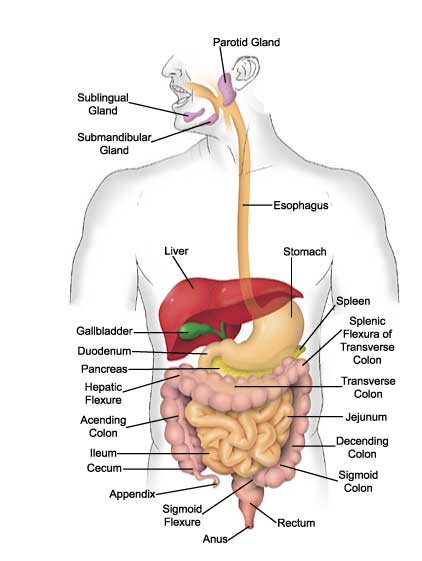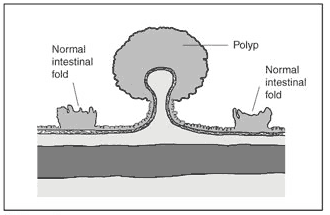
Digestion & Digestive Health - Polyps
Colon Polyps
A colon polyp is a growth on the surface of the colon, also called the large intestine. Sometimes, a person can have more than one colon polyp. Colon polyps can be raised or flat. The large intestine is the long, hollow tube at the end of your digestive tract. The large intestine absorbs water from stool and changes it from a liquid to a solid. Stool is the waste that passes through the rectum and anus as a bowel movement. Colon cancer and cancer of the rectum usually begin as a small polyp. While most colon polyps are benign, some do become cancerous. But some types of polyps may already be cancer or can become cancer. Flat polyps can be smaller and harder to see and are more likely to be cancer than raised polyps. Polyps can usually be removed during colonoscopy—the test used to check for colon polyps.
The large intestine absorbs water from stool and changes it from a liquid to a solid. Stool is the waste that passes through the rectum and anus as a bowel movement. Colon cancer and cancer of the rectum usually begin as a small polyp. While most colon polyps are benign, some do become cancerous. But some types of polyps may already be cancer or can become cancer. Flat polyps can be smaller and harder to see and are more likely to be cancer than raised polyps. Polyps can usually be removed during colonoscopy—the test used to check for colon polyps.
Who can get colon polyps
Anyone can get colon polyps, but certain people are more likely to get them than others. You may have a greater chance of getting polyps if
•you’re 50 years of age or older
•you’ve had polyps before
•someone in your family has had polyps
•someone in your family has had cancer of the large intestine, also called colon cancer
•you’ve had uterine or ovarian cancer before age 50
You may also be more likely to get colon polyps if you
•eat a lot of fatty foods
•smoke
•drink alcohol
•don’t exercise
•weigh too much
Symptoms of colon polyps
Most people with colon polyps do not have symptoms. Often, people don’t know they have one until the doctor finds it during a regular checkup or while testing for something else.  But some people do have symptoms, such as
But some people do have symptoms, such as
•bleeding from the anus. The anus is the opening at the end of the digestive tract where stool leaves the body. You might notice blood on your underwear or on toilet paper after you’ve had a bowel movement.
•constipation or diarrhea that lasts more than a week.
•blood in the stool. Blood can make stool look black, or it can show up as red streaks in the stool.
If you have any of these symptoms, see a doctor to find out the problem.
Testing for Colon Polyps
The doctor can use one or more tests to check for colon polyps.
•Barium enema. The doctor puts a liquid called barium into your rectum before taking x rays of your large intestine. Barium makes your intestine look white in the pictures. Polyps are dark, so they’re easy to see.
•Sigmoidoscopy. With this test, the doctor puts a thin, flexible tube into your rectum. The tube is called a sigmoidoscope, and it has a light in it. The doctor uses the sigmoidoscope to look at the last third of your large intestine.
•Colonoscopy. The doctor will give you medicine to sedate you during the colonoscopy. This test is like the sigmoidoscopy, but the doctor looks at the entire large intestine with a long, flexible tube with a camera that shows images on a TV screen. The tube has a tool that can remove polyps. The doctor usually removes polyps during colonoscopy.
•Computerized tomography (CT) scan. With this test, also called virtual colonoscopy, the doctor puts a thin, flexible tube into your rectum. A machine using x rays and computers creates pictures of the large intestine that can be seen on a screen.
The CT scan takes less time than a colonoscopy because polyps are not removed during the test. If the CT scan shows polyps, you will need a colonoscopy so they can be removed.
•Stool test. The doctor will ask you to bring a stool sample in a special cup. The stool is tested in the laboratory for signs of cancer, such as DNA changes or blood.
Should you get tested for colon polyps?
Talk with your doctor about getting tested for colon polyps if you’re 50 years of age or older, or earlier if you have symptoms or someone in your family has had polyps or colon cancer.
Treatment of Colon Polyps
In most cases, the doctor removes colon polyps during sigmoidoscopy or colonoscopy. The polyps are then tested for cancer. If you’ve had colon polyps, the doctor will want you to get tested regularly in the future.
Colon Polyps - Howto Prevent Colon Polyps?
There is no one sure way to prevent colon polyps. But you might be able to lower your risk of getting them if you
•eat more fruits and vegetables and less fatty food
•don’t smoke
•avoid alcohol
•exercise most days of the week
•lose weight if you’re overweight
Eating more calcium may also lower your risk of getting polyps. Some foods that are rich in calcium are milk, cheese, yogurt, and broccoli.
Taking a low dose of aspirin every day might help prevent polyps. Talk with your doctor before starting any medication.
Remember
•A colon polyp is a growth on the surface of the colon, also called the large intestine.
•Colon polyps can be raised or flat.
•Some colon polyps are benign, which means they are not cancer.
•Some types of polyps may already be cancer or can become cancer. Flat polyps can be smaller and harder to see and are more likely to be cancer than raised polyps.
•Most people with colon polyps do not have symptoms.
•Symptoms may include constipation or diarrhea for more than a week or blood on your underwear, on toilet paper, or in your stool.
•Doctors remove most colon polyps and test them for cancer.
•Talk with your doctor about getting tested for colon polyps if you’re 50 years of age or older, or earlier if you have symptoms or someone in your family has had polyps or colon cancer.
Read More about Polyps :
- Colon Polyps and Cancer - A polyp is a projection or a "bump" of the bowel wall protruding into the lumen. Polyps may occur anywhere in the gut, but here we will focus only on colon and rectum.
Polyps occur in as many as 40-50% of the population. The number and size of polyps increases with one's age, especially in patients with family history of colon polyps or cancer. High fat, low fiber diet and smoking may play an important role in the causation of these polyps, whereas use of aspirin and similar drugs decrease the risk.
Polyps can be of various sizes, shapes and microscopic structure. Most polyps, when examined under the microscope, demonstrate a benign pathology. However, some of these "benign" polyps can and do go on to become cancer, and are thus precancerous. This type of polyp is known as adenoma. Most colon cancers arise from these precancerous polyps. It takes about 5-10 years for a benign polyp to transform into cancer. While most colon cancers arise from these polyps, most precancerous polyps do not go on to cancer. Polyps of the "hyperplastic" variety are not believed to be precancerous. Continue to read about Colon Polyps and Cancer - Colon Cancer Screening - March is colon cancer awareness month. Did you know that colon cancer is America's number two cancer killer? Did you know that we can prevent these unnecessary deaths by removing pre-cancerous polyps and by diagnosing cancer at early stages? Did you know that screening for colon cancer is cost-effective and saves lives?
Polyps versus cancer
As many as 95% of colorectal cancers begin as polyps. It takes about 7-10 years for pre-cancerous polyps to transform into cancer. After this initial transformation, the cancer takes about 1-3 years to spread, and this process is known as metastasis. Up to 80% of colon cancer deaths can be prevented by timely removal of the pre-cancerous polyps!
The goal is to screen the people before any symptoms develop. Once the symptoms of bleeding, pain or altered bowel habit appear, over half of the cancers have already spread. Continue to read about Colon Cancer Screening.
Prevent Colorectal Cancer - Get Colonoscopy - First Live Colonoscopy |